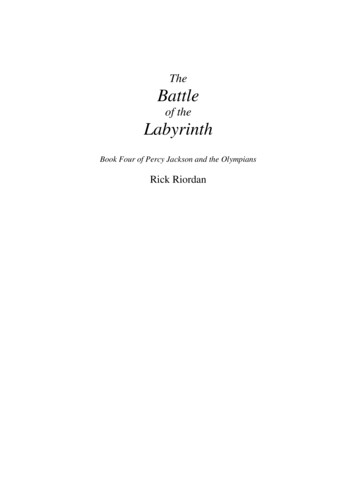
Transcription
Battle for the Mind
We have still much to learn as to the laws according towhich the mind and body act on one another, and according to which one mind acts on another; but it is certain thata great part of this mutual action can be reduced to generallaws, and that the more we know of such laws the greaterour power to benefit others will be.If, when, through the operation of such laws surprising eventstake place, (and) we cry out “Such is the will of God,” instead of setting ourselves to inquire whether it was the will ofGod to give us power to bring about or prevent these results;then our conduct is not piety but sinful laziness.George Salmon, D.D.A Sermon on the Work of theHoly Spirit (1859)
BATTLE FORTHE MINDA PHYSIOLOGY OF CONVERSIONAND BRAIN-WASHINGbyWilliam Sargantwith a Preface byCharles Swencionis
This is a Malor BookPublished by ISHKP. O. Box 176, Los Altos, CA 940231997, 2011 by Margaret SargantAll rights reserved under International and Pan-AmericanCopyright Conventions.First Published in 1957 by Wm. Heinemann Ltd.Second edition in 1959 by Pan Books Ltd.Malor Books paperback edition published in 1997 by ISHKSargant, William Walters.Battle for the mind : a physiology of conversion and brain-washing /by William Sargant : with a preface by Charles Swencionis.p. cm.Originally published: New York : Doubleday, 1957.Includes bibliographical references and index.ISBN 1-883536-06-51. Brainwashing, 2. Conversion–Psychology. 3. Rites andceremonies.I. TitleBF633.X3 1997153.8’53––dc2197-10363
C o nt ent sPrefaceby Charles SwencionisviiForewordxviiIntroductionxxi1 Experiments in Animals12 Animal and Human Behaviour Compared243 The Use of Drugs in Psychotherapy474 Psychoanalysis, Shock Treatmentsand Leucotomy605 Techniques of Religious Conversion816 Applications of Religious Techniques1227 Brain-Washing in Religion and Politics1518 Brain-Washing in Ancient Timesby Robert Graves1919 The Eliciting of Confessions20310 Consolidation and Prevention24811 General Conclusions269References275Bibliography283Index287
AcknowledgementsThe sources of all quotations are given as references at theend of this book. The author and publishers of Battle forthe Mind thank those who granted permission for thesequotations to be used.All photographs and plates are reproduced by courtesy ofThe British Museum, London, and are copyright TheBritish Museum.
Prefaceby Charles SwencionisWilliam Sargant asked how the brain could change rapidly to adopt whole new world-views. His interest was neither religious nor antireligious, but rather in how the braincould accommodate such rapid and far-reaching change.In cases like conversion and brain-washing, the meanings of many or most parts of one’s world change. For thebrain, this is a change not like the world revolving on itsaxis, but rather of changing its axis and drawing all newlines of latitude and longitude, or of great shifts in tectonicplates, so the parts of the world stand in new relations toeach other. The brain has to change its connections andmeaning systems. How can it possibly do this quickly?Forty years after it was written, Sargant’s Battle forthe Mind makes disparate and complicated mental andbehavioral phenomena understandable. His research inWorld War II showed that with enough battle exposure,every soldier eventually shows the symptoms of battlefatigue, shell-shock, or what we know now as posttraumatic stress disorder (PTSD). He went further tolook at similar processes in religious conversion, spiritpossession, brain-washing, political conversion, and theconsultation of oracles in the ancient world.His basis was a Pavlovian theory, formulated more thanseventy years ago. The theory he used is distinct from
viiiBattle for the MindPavlov’s famous theory of classical conditioning. It sharesmuch with modern theories of PTSD, and even now couldenlighten them. Sargant extended Pavlov’s model to accountfor experiences that make people change their world-viewsuddenly. They begin to see themselves as part of a newgroup, or to become vulnerable to ideas very different fromtheir usual assumptions.The principles of how to do this were known by the czar’ssecret policy and others long before Pavlov’s time. How thebrain might allow this is another matter.Sargant asked how it could be that people would changelong-standing, reasonable beliefs, drop their ordinary perspectives of common sense, and become open to ways ofthought quite foreign to their previous lives. He found apattern common to these situations. First, people were subjected to intense trauma. The trauma continued until people behaved in ways very different from what was usual forthem. Their personalities showed signs of breaking down.New ways of thinking, applied intentionally or by accident,could then be easily accepted.In brain-washing, trauma is applied through sleep deprivation, relentless pressure of an alternative ideology, andphysical abuse. In religious conversion the trauma is internal, a conflict between fear of hellfire and damnation versusacceptance of the new religion. In spirit possession, thereis no trauma, but pressure of a heightened emotional pitchcan come from repetitive drum-beating, chanting, dancing,and drug or alcohol use. The mental set, environmental setting, expectation, and observation of others being possessedsuggest to people how they should act. Consulting an oraclein the ancient world was not a rational process. Visiting an
Prefaceixoracle involved sleep deprivation, chanting, drug use, solitary passage through tunnels and down pits and long exhausting sessions that could last over several days. Whenthe oracle then announced a revelation, it could be seenwith new eyes and perceived as having great importance.Pavlov’s Model of Brain ChangesPavlov’s dogs were almost drowned in a flood. At the lastmoment, an assistant rescued them, freed them from theircages, and led them to safety. Afterwards, they forgot or reversed training they had received before the trauma. Keepers they had shown affection to they now showed aggression toward. Keepers they had disliked they now showedaffection for. They forgot their recent learning and had tobe retrained.This phenomenon interested Pavlov and he studied it. Hetheorized that there were three stages to this breaking downof neural organization and a fourth of reassembling theworld. First, the animal is overloaded, through excessive exercise, excessive sensory stimulation, surgery, or sleep deprivation. This produces what Pavlov called the “equivalent”phase of brain activity. In the “equivalent” phase all outsidestimuli, large or small, produce the same size response. Youmay see this in people who have been sleep deprived for aday or two. They lose judgment and perspective and reactto a slight question or a major challenge with the same degree of irritability.
xBattle for the MindThe second stage Pavlov called “paradoxical inhibition,” in which weak stimuli produce strong responsesand strong stimuli produce weak responses. Judgment isfurther impaired. One almost never observes people inthis state in normal life. They are responding inappropriately, with four fire engines to a firecracker and no reaction to a real four-alarm fire. This and the further stagesare seen in soldiers, in civilians subjected to war, andpeople in normal societies subjected to rape, or otherhorrible traumas.In the third “ultra-paradoxical” stage many positiveconditioned responses become negative and vice versa.The dogs showed paradoxical responses to their keepers.They became friendly to keepers they formerly dislikedand disliked ones they had been close to. In people, therecan be feelings of possession, hypnosis-like states, andnew commands and ideas become imperative.The state of “transmarginal” collapse is even beyond the“ultra-paradoxical” stage. In this stage, and after it, the dogseems to have unlearned recent and longstanding routines.Pavlov described this state as one in which there is inertness,temporary inhibition of most brain function, and isolationof functionally pathological points of the cortex.A state of breakdown occurs in which the person ordog cannot function and has lost key markers by whichthey or it understood the world. Basic learning, basic assumptions about the world have been challenged. If theperson or dog could change some of these assumptions,they could build a new map of the world, a differentworld, and function again if the trauma had not been too
Prefacexigreat. Parts of the cortex involved in the trauma becomeisolated from other parts of the brain they used to connect to and fire frequently and in a new manner.Pavlov believed this overall process was the brain’s attempt to avoid complete destruction: that it had to attempt to process trauma so great it called into questionall it had ever learned. This is a model quite differentfrom the classical conditioning for which Pavlov is usually remembered.Implications for Social ProcessesTraumatic, emotional events that people share bring themtogether, make them close. War buddies, school chums, andchildhood friends are stock relationships for literature andfilm. Milder forms of the same techniques appear in hazingin college, which leads to life-long attachment to the almamater and to friendships. Training exercises in sports activate“team spirit”; indoctrination in boot camp leads to loyalty;and corporate training sessions establish commitment to thecompany. More extreme versions exist in militant religiousand political groups and in urban teenage gangs. These powerful techniques can bring about allegiance for a lifetime.Walter Freeman suggests that the process of conversionis not an evil manipulation, but a social necessity, and thatperhaps the same chemistry provides the mechanisms fortransference in psychotherapy. The biological process maybe the dissolution of existing neural connections by anelectrochemical discharge in a brain, preceded by stress,and followed by a state of malleability. This could open the
xiiBattle for the Mindway for a new belief structure to facilitate social behavior.Such a mechanism could serve the function of allowingyoung adults to separate from their parents, form theirown social units, and become parents themselves. That thismechanism exists at least in humans and dogs leaves openfor investigation whether it evolved performing this socialfunction, or whether it is an epiphenomenon.Little is known about this mechanism Sargant described.It would be a mistake to wall it off into the corner of beingonly PTSD: one psychiatric syndrome in a list of many.This mechanism holds the possibility of explaining and understanding much of how people suddenly change direction in life, and some of the strangest religious and spiritualbehavior ever described among human beings.Could this explain the behavior of the snake-handlingcults of the American South, flagellant bands offering supplication to God to avert the Black Plague in the fourteenthcentury, the strength of the Mau Mau movement in Kenyain the 1950’s, and the spirit possession in African traditions? Could this be why people believed so powerfully inthe revelations of ancient oracles?Current Models of PTSDCurrent models of PTSD help us understand parts of howPavlov and Sargant’s mechanism works. Models of PTSDfall into roughly four categories: neurochemical; kindling;conditioning; and cognitive.The neurochemical models suggest that PTSD can be understood as inescapable stress producing learned helplessness. The individual cannot escape repeated trauma and
Prefacexiiiso learns that nothing he or she does matters. This produces chronic dysregulation in neurotransmitter systems.The neurotransmitter levels are no longer subject to normal checks and balances and may become set at abnormallevels. Some stress hormones are not secreted when theyshould be and others are in the bloodstream constantly athigher levels than normal. Mechanisms of reacting appropriately to stress have been burnt out. Stress alarms havebeen activated so frequently or extremely that they will nolonger fire when needed and a lurking anxiety never leaves.The kindling models suggest that trauma sets up a set offoci in the brain that fire frequently, repeatedly, and inappropriately. This reinforces memory of the trauma and interrupts ongoing processing. If memory of the trauma iseither stored in certain circuits or foci, or these brain structures form an important part of the memory, trauma memories will be more active than other memories, and intrudeon other thoughts and activities.Conditioning models suggest that biological vulnerability, acted on by social trauma, causes intense fear, distress,or some other basic negative emotion. This leads to ongoinganxious apprehension, or psychological vulnerability. Whenthis is acted on by social support and coping responses, itleads to full-blown PTSD.Cognitive models suggest that an individual’s world viewis challenged by a traumatic event to the breaking point. Somany assumptions formerly held of human nature and theways the world should or does function become so untenable that the world-view shatters.
xivBattle for the MindApplicationsIf we understand how this mechanism works, we couldmanipulate it consciously. Cynical, tyrannical uses to control human beings are obvious and have been a part of ourpast and present and will be a part of our future. Brainwashing has been used by cults, governments, advertisers,and professional training institutions. It may be a mainstay of all forms of even legitimate socialization into society.Beneficial application is also possible. Treatment of PTSDshould be possible by using a version of the process tobring victims back, to reintegrate them into society. Itwould be cruel and unethical to use trauma in such aprocess, but the use of drumming, chanting, music, anddancing does not seem out of place, if the patient wishesit and the process is under the patient’s control.Seeing Sargant’s phenomenon only as PTSD ignores thehealing aspect of its resolution. Granted that some traumas are so severe that people never recover, most are notthis severe, and most people do recover. Understandingthe process yields the possibility of individuals exertinggreater control over their own healing process, directingwhere they want it to go, and which people they wish tostrengthen their bonds with. People who are recoveringfrom trauma have impaired understanding and choice,necessitated through Pavlov’s process of breaking downexisting neural connections. However, enlightened professionals who understand the process should be able toempower victims to a far greater degree than those who
Prefacexvare ignorant of the process. It is quite possible that traumavictims themselves can control their healing to a far greater extent than we now foresee.In these days of brain imaging, we may even investigateexactly what structures and circuits are involved. Such research could suggest drug treatments for PTSD that aremore successful than current ones.Our society is full of people convinced that they holdthe best of all political, social, religious, and other positions. They (and perhaps we) have not a clue that thesepositions are not the result of rational choice, but someaccident of social conditioning. Insight into this processand education that it exists might make people more capable of rational, informed choice in ideology, or even toreject ideology and dogma in favor of dealing with reality.Perhaps most important, understanding Sargant andPavlov’s mechanism can give us insight into the formationof social bonds, the development of gangs and groups, andallow us to make more informed choices as individuals, asa society, and as a culture, how we want our own groupsto develop.BibliographyFreeman, Walter J. Societies of Brains: A Study in the Neuroscience ofLove and Hate. Hillsdale, NJ, Lawrence Erlbaum Associates; 1995.Giller, Earl L. Biological Assessment and Treatment of Posttraumatic StressDisorder. Washington, American Psychiatric Press; 1990.Herman, Judith L. Trauma and Recovery. New York, Basic Books; 1992.Jones, Jennifer C., & Barlow, David H. A new model of posttraumaticstress disorder: Implications for the future. In P.A. Saigh (Ed.), Posttraumatic Stress Disorder. Boston, Allyn and Bacon; 1992.
xviBattle for the MindKrystal, John H., Kosten, T.R., Perry, B.D. et al. Neurobiological aspects of PTSD: Review of clinical and preclinical studies. BehaviorTherapy, 20:177-178; 1989.Krystal, John H. Animal models for posttraumatic stress disorder. InEarl L. Giller, (Ed.) Biological Assessment and Treatment of Posttraumatic Stress Disorder. Washington, D.C., American PsychiatricPress; 1990.van der Kolk, B., Greenberg, M., Boyd, H. et al. Inescapable shock,neurotransmitters, and addiction to trauma: Toward a psychobiology of post-traumatic stress. Biological Psychiatry, 20:314-325: 1985.Yehuda, Rachel, Southwick, Steven M., Perry, Bruce D., Mason, JohnM., & Giller, Earl L. Interactions of the Hypothalamic-PituitaryAdrenal Axis and the Catecholaminergic System in PosttraumaticStress Disorder. In Earl L. Giller, (Ed.) Biological Assessment andTreatment of Posttraumatic Stress Disorder. Washington, D.C.,American Psychiatric Press; 1990.Charles Swencionis, Ph.D.Ferkauf Graduate School of PsychologyAlbert Einstein College of Medicine ofYeshiva UniversityBronx, NYNovember, 1996
ForewordIt must be emphasized as strongly as possible that thisbook is not concerned with the truth or falsity of any particular religious or political belief. Its purpose is to examine some of the mechanisms involved in the fixing or destroying of such beliefs in the human brain. Some criticswill perhaps doubt whether it is possible to separate twoparts of a whole in this way. But if a greater understandingof the problem is ever to be achieved, continued attemptsmust be made to do so.Having beliefs of my own, and owing much to a religious upbringing, I am particularly anxious to give aslittle offence as possible to readers who may hold similaror quite different religious tenets. Yet history records theangry outcry even when Newton tried to disentangle thesimple mechanics of gravity from its religious aspects. Adeeply religious man himself, he was accused of trying todestroy religious faith in others. He could answer only thathis work was concerned not with the ultimate question ofwhy something happens, but with the immediate questionof how it happens; and I must make the same plea for thisvery much humbler enquiry. Many people have pointedout, quite rightly, that the ultimate test of both religiousand political values is not definable in terms of how it happens, but of what is achieved.My concern here is not with the immortal soul, whichis the province of the theologian, nor even with the mind
xviiiBattle for the Mindin the broadest sense of the word which is the province ofthe philosopher, but with the brain and nervous system,which man shares with the dog and other animals. Yet it isthrough this material brain that emissaries of God or of theDevil—dictators, policemen, politicians, priests, physiciansand psychotherapists of various sorts—may all try to worktheir will on man. It is not surprising therefore that arguments often arise as to who exactly is doing what. This studydiscusses mechanistic methods influencing the brain whichare open to many agencies, some obviously good and someobviously very evil indeed; but it is concerned with brainmechanics, not with the ethical and philosophical aspectsof a problem which others are very much more competentto discuss than I am. It must also be remembered that muchof what is discussed here is still only a useful working hypothesis; a great deal of further research is needed beforefinal conclusions are reached.My choice of Wesley for special study in the technique ofreligious conversion was prompted by my own Methodistupbringing. I became convinced of the tremendous powerlatent in his methods, though these have now been abandoned by the Church which he built and strengthened bytheir use; and most people will agree with social historianswho insist that his conversion of large areas of the BritishIsles helped to stave off political revolution at a time whenWestern Europe and North America were in a ferment, orin actual revolt, largely because of the anti-religious, materialistic philosophy with which Tom Paine, among others, was associated. John Wesley, and his methods, demandparticular study at the present time from politician andpriest alike, even if the hellfire doctrine he preached may
Forewordxixseem outmoded. I have had to go outside my own field ofmedicine for some of the material used in this book andapologize in advance for any inaccuracies due to this. Butif progress and synthesis are ever to be achieved, in thisage of increasingly departmentalized knowledge, someonehas to risk leaping over walls into other people’s territory.And it must not be held against me that I do not discusssome types of purely intellectual conversion, but only thosephysical or psychological stimuli, rather than intellectualarguments, which seem to help to produce conversion bycausing alterations in the subject’s brain function. Hencethe term “physiology” in the title.I have to acknowledge the advice and help of more peoplethan can be mentioned by name, who have visited or workedwith me either at home or in the U.S.A. They are bound tofind some of their viewpoints incorporated in my thinking,and I hope they would not wish it to be otherwise. In particular I have to thank Drs. Eliot Slater and H. J. Shorvon;some of our work done together in England during and after the war is reported in the earlier chapters of this bookand has been already published in joint papers by scientificjournals. All the material on war neuroses here quoted hasappeared in such journals, and references are appended.The Rockefeller Foundation made it possible for me tospend a valuable year at Harvard University and to see psychoanalytic teaching and treatment at close quarters. Letme emphasize that my discussion of psychoanalysis whenillustrating some aspects of modern conversion and brainwashing techniques implies no denial of its very real valuein the treatment of carefully selected patients. Another year
xxBattle for the Mindspent, by invitation, at Duke University allowed me to studymethods of religious revival, including the Christian snakehandling cults that flourish in the Southern States. I alsoowe much to Drs. Howard Fabing and George Sutherlandwith whom, while in the U.S.A., I frequently discussed therelation of Pavlov’s work to problems of human behaviour.My thanks are also due to Robert Graves. It was he whopersuaded me, whilst on a visit to Majorca, to continuewith this book, helped me to prepare the final manuscript,and also supplied Chapter 8 and some of the other historical references in support of my arguments.And without the help of my wife, and my secretary, MissM. English, this book could never have been written at all.W. S.
IntroductionPoliticians, priests and psychiatrists often face the sameproblem: how to find the most rapid and permanentmeans of changing a man’s beliefs. When, towards the endof World War II, I first became interested in the similarity of the methods which have, from time to time, beenused by the political, religious and psychiatric disciplines,I failed to foresee the enormous importance now attachingto the problem—because of an ideological struggle thatseems fated to decide the course of civilization for centuries to come. The problem of the doctor and his nervouslyill patient, and that of the religious leader who sets out togain and hold new converts, has now become the problemof whole groups of nations, who wish not only to confirm certain political beliefs within their boundaries, butto proselytize the outside world.lGreat Britain and the U.S.A. therefore find themselvesat last obliged to study seriously those specialized forms ofneuro-physiological research which have been cultivatedwith such intensity by the Russians since the Revolution,and have helped them to perfect the methods now popularly known as “brain-washing” or “thought control”. InAugust, 1954, the United States Secretary of Defence announced the appointment of a special committee to studyhow prisoners of war could be trained to resist brain-washing. He admitted the desirability of reviewing the existing laws, government agreements, and policies of military
xxiiBattle for the Minddepartments, with regard to prisoners captured by nationsin the Soviet orbit. This committee reported back to thePresident in August, 1955.2In Great Britain, too, the necessity for more vigorousresearch into the techniques of rapid political conversionhas also been widely recognized. Several years ago, forinstance, Mrs. Charlotte Haldane pleaded that researchshould be undertaken into the psychological mechanismof the process by which she, the wife of a famous Britishscientist, had been converted to a belief in the official Russian interpretations of Marxian dialectics; and into thatof her sudden reconversion to the Western point of view,after failing to detect the falsity of the Russian system forso many years. Koestler and many others have describedvery much the same experience in their own lives.3Many people are also bewildered at the spectacle of anintelligent and hitherto mentally stable person who hasbeen brought up for trial behind the Iron Curtain, andprevailed upon not only to believe but to proclaim sincerely that all his past actions and ideas were criminallywrong. “How is it done?” they ask.It is not always realized that this can be the politicalequivalent of that kind of religious conversion after whichordinary decent people suddenly come to believe thattheir lives have not only been useless but merit eternaldamnation, because some religious particular has been neglected. The same psychological process may also be seenat work in a patient undergoing psychoanalysis: he canbe persuaded that anomalies in his behaviour have beencaused by an intense hatred of his father—even though he
Introductionxxiiihas always acted in a devoted and affectionate manner towards him. How can people be induced to believe in whatmay contradict obvious fact?1A general distinction should be made between the moregradual changes of outlook and behaviour due to increasingage, experience and reason and the abrupt total re-orientations of viewpoint, often brought about by others, whichinvolve the surrender of strongly held beliefs and the adoption of new beliefs often diametrically opposed to them.This book will discuss some of the more importantmechanistic and physiological aspects of this problem,and of how new ideas may be implanted and firmly fixedin the minds even of those unwilling at first to receivethem. Interest in it was stimulated by chance circumstances eleven years ago. World War II provided medicinewith rare opportunities for studying the breakdown ofnormal persons subjected to intense stresses. In Englandat the time of the Normandy invasion in June, 1944, specialarrangements had been made to deal with a new crop ofacute military and civilian neuroses resulting from this operation. One day while travelling to an emergency neurosiscentre, soon after the start of the invasion, I stopped at anAmerican neuro-psychiatric hospital to visit a colleague,Dr. Howard Fabing. He had just been reading a book bythe famous Russian neuro-physiologist I. P. Pavlov, calledConditioned Reflexes and Psychiatry,4 and strongly advisedme to do the same at once. This book consisted of a seriesof lectures given by Pavlov not long before his death in1936 at the age of eighty-six; but they had not becomeavailable in English until 1941. Stocks of the translation
xxivBattle for the Mindhad been destroyed in the London Blitz that same year, butDr. Fabing had managed to secure a copy. Like several otherneuro-psychiatrists of World War II, he had found Pavlov’sobservations on animals extremely useful for the better understanding of certain behaviour patterns observed whenhuman beings break down under abnormal stress.5Pavlov’s clinical descriptions of the “experimental neuroses” which he could induce in dogs proved, in fact, to havea close correspondence with those war-neuroses which wewere investigating at the time. Also, many of the physicaltreatments that had gradually been developed by trial anderror during the war to relieve acute nervous symptoms,had obviously been anticipated by Pavlov as a result of hisprolonged research on dogs.4 It was now clear that whatwas needed was a much more careful study of certain ofthese findings, in their possible relation to human psychiatry, than had recently been given them either in England orin America.So close were some of the similarities between these andcanine neuroses that it seemed more improbable than everthat many current psychological theories about the originof human neuroses and other abnormalities of behaviourwere correct; unless it be conceded that Pavlov’s dogs hadsubconscious minds, and also super-egos, egos and ids. Andthe part played by alterations in the function of the human brain itself had, it also seemed, been too summarilydismissed by some in their attempts to explain the reasonsnot only for neurotic and criminal behaviour but for all theconstant mental turns, reconsiderations and adjustmentswhich produce so-called “normal” behaviour in any givenperson, as he reacts to his environment.
IntroductionxxvWhen, late in life, Pavlov began comparing the results ofdisturbances of brain function noted in his animals withthose noted in human beings, this phase of his work waslittle studied outside Russia, and many British and American psychiatrists still neglect it, although the relevant bookshave now been long available in both countries. The fact isthat Pavlov c
the Mind makes disparate and complicated mental and behavioral phenomena understandable. His research in World War II showed that with enough battle exposure, every soldier eventually shows the symptoms of battle-fatigue, shell-shock, or what we know now as











